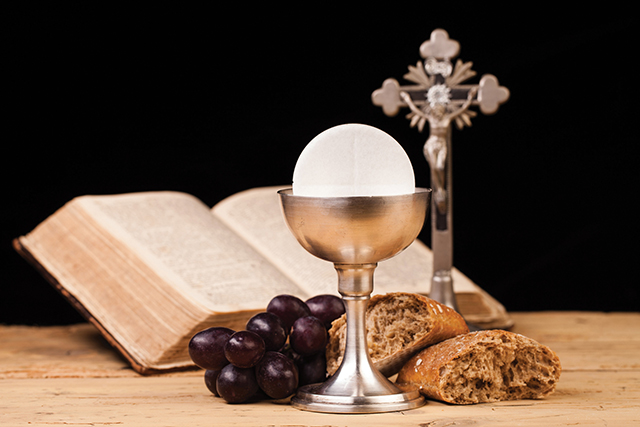What’s the point of chastity?

Chastity is the goal for all of us, whether we marry, remain single, or enter religious life or the priesthood. (Photo: iStock, monkeybusinessimages)
WHEN I WAS a chaplain at a Catholic college years ago, a young woman came to me greatly concerned about her relationship with her boyfriend. Namely, she felt pressured to further the physical intimacy between them. It wasn’t all coming from his direction, she wanted to be clear; the urgency was inside her, too. “My parents trust in me,” she lamented. “And I know I owe it to the man I’ll marry one day not to do this. But I’m afraid I will.”
I felt the weight of this woman’s sadness and disappointment in herself. But what also seemed apparent to me was her lack of self-possession. She betrayed the belief that she belonged, first to her parents, and later to a husband who had not yet appeared on the scene. Because of this attitude, she couldn’t make a decision about her body, her sexuality and dignity and mystery, with her own best interests at heart.
The problem of self-possession is a big one on the road to sexual maturity. We have to own ourselves before we can have the freedom to share ourselves. Self-possession is especially important for people primed with “boundary issues”: those who have been abused or molested physically or psychologically.
But even if we were favored with parents and adults who respected us and gave us the gift of strong, self-reliant identities, arriving at the goal of mature sexuality—chastity—is not necessarily a walk in the park.
Chastity for all
Chastity is the goal for all of us, whether we marry, remain single, or enter religious life or the priesthood. It is a virtue we should all seek to deliberately cultivate. So let’s start with a definition: What exactly is chastity?
The Catechism of the Catholic Church defines chastity as the successful integration of sexuality within the person (no. 2337). This definition speaks of a much greater achievement than preserving one’s virginity for one’s spouse or simply remaining celibate altogether, which is how many of us were perhaps taught to view this virtue. Chastity comes under the cardinal virtue of temperance, which involves “permeating the appetites of the senses with reason”—using discernment to govern physical instinct. Obviously not every impulse we have to eat, drink, buy, take, or do is a wise one. Our values assist us in making responsible choices in all of these matters, including how to use and not misuse the sexual energy that makes us the vital people we are.
If that sounds too academic for you, how about learning how to dance with your “holy hormones,” as Catholic psychologists Sister Fran Ferder, F.S.P.A. and Father John Heagle describe the practice of chastity? Most young adults I’ve surveyed agree that it’s hard for them to put “holiness” and “sex” in the same sentence, but that’s precisely what chastity invites us to do.
The body is central to Christianity
It’s also what the late Pope John Paul II did in his famous lectures on the “theology of the body.” In 129 Wednesday audiences, the pope offered a gracious, positive, and expansive understanding of the gift of human sexuality—which, frankly, may not be what you might expect of a pope. And that’s unfortunate, because the human body is central to Christian doctrine. Think of it: Creation. Salvation. Incarnation. Crucifixion. Resurrection. Ascension. Assumption. How could you even tell the Christian story without noticing the emphasis on the fate of the body?
Our central sacrament—the Eucharist—is body-centered, too. And in the humblest terms, all sacraments are about “birth and death, sex and food, sin and sickness,” Cardinal Timothy Radcliffe, O.P. points out in his excellent book, What Is the Point of Being a Christian? If God is to meet us anywhere, it has to be in the body, which is our only real address. It is here that we reside, here that we live and move and have our being.
At the same time, we have to be careful of false distinctions. “We are not spirits trapped in bags of flesh,” Radcliffe notes. We are our bodies as much as we are spirit. Escaping that reality is no more possible, or desirable, than escaping our spiritual natures. God, after all, gave us both: the divine likeness embossed in flesh and blood. So we can’t expect to give away our bodies without giving over ourselves in some crucial sense, too. Radcliffe describes sexual intimacy as a sacred hour: “Each says to the other: ‘Here is my body for you.’ It is a profoundly eucharistic act.”

Being life-giving
Approaching our sexuality as eucharistic helps us to appreciate the need to be good stewards of this gift. Sacraments are signs whose physical elements participate in deeper and divine realities. We speak of these as mysteries, and it’s not hard to see why John Paul II urged in his “theology of the body” that men and women must become masters of their own mystery in embodying and expressing their sexuality.
Clearly this gift involves much more than engaging in sexual acts. Our sexuality is unitive energy. It’s communion in the widest possible sense. Sexual energy, as Fran Ferder notes, argues against being alone. It generates within us the search for love, family, community, friendship, and creativity of every sort. It even propels the search for God. This is why saints often described their encounters with the Holy One in the language of ecstasy.
John Heagle reminds us that the biological goal of sexual energy is to generate new life. He adds that if we don’t answer the call to generativity literally—in sexual intimacy and procreation—the question doesn’t go away: How else will we answer the call to give life? Whoever we are, the longing is urgently felt. Chastity is about answering that call moment to moment with integrity according to our station in life.
From here to chastity
But how do we get from “here” to chastity, if “here” is a history of poor sexual stewardship? I’m well aware that if I were a college chaplain today, I wouldn’t be encountering as many students worried or guilty about their first sexual experience. Many young people suspect that when it comes to practicing chastity, that ship has sailed and they weren’t on it. Many schools support this impression by passing out birth control and condoms rather than educating for a mature understanding of sexuality involving temperance. One of the most surprising defenders of the role of self-mastery in sexuality comes from a 2007 movie called Juno, which is worth seeking out.

Juno, the protagonist, is a 21st-century teen with the opposite problem of the young woman whose story I told at the beginning. Juno is entirely self-possessed—as children of divorce often need to be. She therefore thinks of her body as a possession: as her property, not her self. This makes it easy to “hook up” with her best friend to find out what this sex business is all about. The arrangement is casual, but not as consequence-free as anticipated.
What Juno learns is how very much she is her body and cannot separate herself from it. A third party—one with fingernails, no less—gets hold of her life and from within begins to teach her the connective power of her sexuality. This unborn child assists Juno in healing the memories of her original broken family, strengthening the bonds within her present one, and creating new possibilities for an adoptive mother.
Through these experiences Juno learns to trust in people, however imperfect their love is. Her fierce little note to the adoptive mother becomes a manifesto of hope: “If you’re still in, I’m still in.” This life-affirming story serves as a beacon for those of us who suspect we’ve already betrayed the promise of our sexuality by following society’s nod to trivializing sex: as entertainment, as romance, or a mere feeding of a biological hunger.
Juno can’t recover the day before she entered into sexual awareness, but she doesn’t have to crawl into the pigeonhole of “sexually active” to which others invariably consign her. Hers is a chastity gained through fire, and she seems ready to be its wise and tender steward.
The Juno approach says to the gift of sexuality, and to family, and to the wider community of love: If you’re still in, I’m still in. It’s a far cry from the just-say-no approach that casts human sexuality in a dark and potentially dangerous light—until a sacrament makes it OK.
The nightly news provides us with all too many examples of politicians, clergy, and celebrities who have failed to integrate their sexuality into their otherwise mature, responsible, and capable identities. Those who do not master temperance will never be the masters of their own lives. Those who do embrace chastity, having taken up their lives, will be happily prepared in the right hour to lay them down.
A version of this article originally appeared in VISION 2009.
Related: VocationNetwork.org, “Celibate chastity: One way to be a sexual person.”
Tags
Related
- Questions Catholics Ask
- What Catholics believe about the Eucharist
- How Jesus embraced his call
- Prayer: Our never-ending conversation with God
- What the church is teaching—and learning—about the sin of racism
- Church defined: Jesus calls; we respond
- A Creed to believe in
- On whose authority?
- Ten great things about being Catholic
- Following Jesus: Be ready for some surprises Read More
Most Viewed
- Find your spirituality type quiz
- Questions and answers about religious vocations
- Celibacy quiz: Could I be a nun? Could I be a brother? Could I be a priest?
- Resources for older discerners or those with physical and developmental differences
- About Vocation Network and VISION Guide


